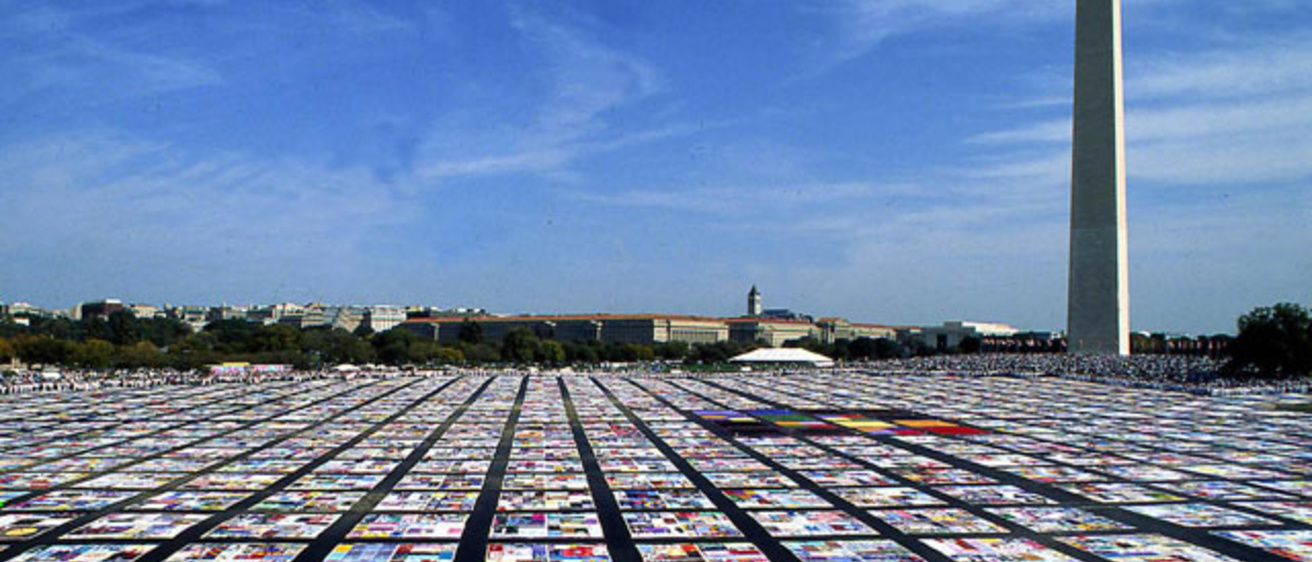Campus Voices is a place for faculty, staff and students to share ideas, views and information about issues that matter to them personally and professionally. The opinions expressed here do not necessarily represent those of the University of Iowa. View more Campus Voices here.
This past summer, for the first time since 1996, the NAMES Project AIDS Memorial Quilt was laid out in its entirety on the National Mall in Washington D.C. At 1.3 million square feet, the Quilt is the largest living monument in the world.
The Quilt has always been carefully catalogued. However, until now, being able to find a particular panel when it is displayed has not been easy, requiring the assistance of NAMES Project personnel. The University of Iowa Digital Studio for Public Humanities was honored to collaborate with NAMES to simplify the search.
With AIDS Quilt Touch, the mobile web app that we developed, a person can, from any Internet-enabled computer or mobile device in the world, look up the name of a loved one, see an image of their quilt panel, learn when it is being displayed, and find its specific location on a map on the day it is displayed. Additionally, and as importantly, for the first time the app allows people to leave “remembrances” in celebration of the life lived.
We were fortunate to visit Washington, D.C. to view the Quilt and experience on site the very first users of our app, as visitors to the Smithsonian Folk Life Festival and XIX International AIDS Conference used it to locate one of the 48,000 panels displayed on the Mall.
Learn more:
UNAIDS: Joint United Nations Programme on HIV/AIDS, an innovative partnership seeking to achieve universal access to HIV prevention, treatment, care and support www.unaids.org/en/
AVERT: International HIV and AIDS charity, based in the UK, working to avert HIV and AIDS worldwide, through education, treatment and care www.avert.org
World AIDS Day: www.worldaidsday.org/about-world-aids-day.php
And while our entire adult lives have been deeply affected by the pandemic, we weren't quite prepared for the emotional and social experience of gathering with thousands on America's most public space to commemorate our loss. A memorial gives us the opportunity to share in the very humanness of our being; in our collective vulnerability; in our suffering; and in our healing.
The Quilt celebrates the lives lost to the pandemic. From the crafting of the very first panel to this day, the project provides a means for friends and family to commemorate a loved one. Composed of panels the approximate size of a coffin—it pays tribute to the lives of close to 100,000 individuals who have died in the AIDS pandemic. Each panel is painstakingly hand-crafted by those who knew and loved these individuals. Each panel carries the emotional weight of a life lived, of loving relationships, and of heartfelt loss.
This summer’s app development effort was marked by two things. One was the raw emotional power of the Quilt itself. It was not a rare occurrence for those of us working on the project to become overwhelmed by the some small Quilt detail. Tissues became a part of our standard office supplies.
The other was the incredible experience of our development team. We discovered the elusive “third brain” of collaboration, where the results are far greater than sum of the individuals’ contributions. Each of us had an overlapping part of the mix of knowledge and skills needed to complete the project—computer coding, visual design, abstract data structures, project management, sensitivity to language—and we discovered the power of sharing these things without reserve in our collective effort.
It did not escape our attention that our collaborative team was tapping into the same human impulse that drove a divergent group of people from all walks of life to come together to create and maintain the AIDS Memorial Quilt—the power of community.
AIDS Quilt Touch extends the Quilt digitally in ways that would be impossible in physical form, to a broader audience, a broader time span. This is often the challenge – making research and knowledge more accessible – and the opportunity afforded by the public digital humanities.
To the question of “When will the quilt be on display?” We can now answer, “It is always on display.” To the question of “Where is it being displayed?” We can now answer, “Everywhere.” But perhaps more important are the digital “celebrations of life” that people can now attach to the panels of their loved ones. AIDS Quilt Touch in this way, enables the weaving of extended narratives into the already rich tapestry of the Quilt, and allows the quilt itself to be an ongoing cultural work in process.
This year marks the 25th anniversary of the AIDS Memorial Quilt, and this Saturday, Dec. 1, marks the 24th World AIDS Day.
An estimated 34 million people are living with HIV worldwide, with over twenty-three million in sub-Saharan Africa, and over a million in America. There is still no cure for HIV, but due to remarkable public health initiatives worldwide, there is renewed optimism, very much in evidence at the International AIDS Conference this summer, that the pandemic can be curtailed and eventually eliminated through aggressive public information, and linked changes in social practices.
We hope AIDS Quilt Touch contributes to this vital effort.
The Digital Studio for Public Humanities AIDS Quilt Touch development team includes:Jon Winet, Mark NeuCollins, Lauren Haldeman, Nikki Dudley, Kelly Thompson, and Kayla Harr
